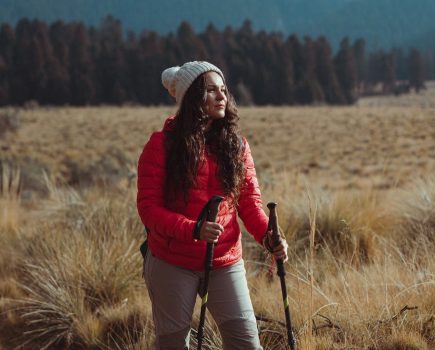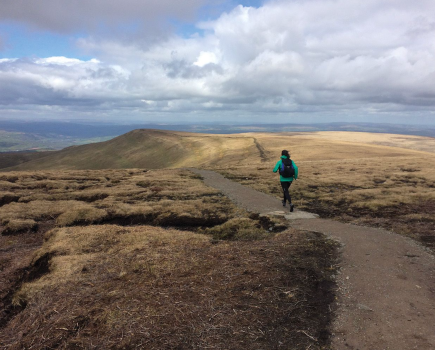The comedian pushes himself to the limit on the sea cliffs of Bude, Cornwall, plus 5 first-time tips
By the time you read this I will have finally finished the stand-up tour that I’ve been doing on-and-off for about nine months now. Artistically and commercially it’s been pretty successful, even if I say so myself. Some 65,000 tickets sold, reviews that were consistently in the 4-5 star region (ok, mainly 4 star) and I certainly can’t complain about “working hard” when I’m only on stage for about 90 minutes a night. My one complaint is that it’s been harder than ever before to fit any mountains into my life.
The tour started with lofty intentions of bagging county tops as I worked my way around the country but, as the gigs rolled on, excursions into the outdoors became fewer and fewer as bad habits crept in and hangovers and lie-ins began taking up ever larger portions of time previously allocated to bracing walks. As a result of this, my fitness level has fallen through the floor, but I didn’t realise just how truly unfit I had become until I was clinging for dear life to some tiny holds on a cliff face in Cornwall with cramping shoulders and legs like jelly.
While bouncing around the West Country on the final week of my tour, experienced climbing guide Stu Bradbury had agreed to introduce me to the joys/thrills/torment (delete as applicable) of sea cliff climbing. Obviously, sea cliff climbing and rock climbing are essentially the same thing but climbing sea cliffs gives you the sound of pounding surf and smell of sea air, lending the whole escapade a sense of drama you simply can’t get inland.
The effect of sea erosion on the cliffs also gives the hand and footholds a different character to what you might be used to. The cliff we arrived at, called Compass Point in Bude, is full of little holds which seemed, to a man of my meagre climbing experience, too insubstantial to be of practical use.
An enthusiastic Stu, however, was keen to impress upon me that once I got my toe in the holds they’d support me happily. “You’ve got proper rock climbing shoes haven’t you?” “I have,” I said, having purchased a pair the day before. I’d had enough of wearing communal climbing shoes and finally decided to buy my own.
On the advice of my climbing mates I had opted for a slightly tighter fit than comfortable but I was worried that I might have overdone it as I felt a bit like one of the ugly sisters desperately jamming my feet into Cinderella’s slippers. “Well you’ll be fine. The slab’s just off the vertical so you can climb harder than you’d think,” he reassured me. “The key is to let your feet do the work and just enjoy yourself.” The thing is, I wouldn’t normally put the phrase “enjoy yourself ” in the same sentence as the word “work” but maybe that’s just me.
I watched as Stu led up a climb called Fruichon. It’s graded as Hard Severe, which is about the limit of what I’ve tackled in the past. From my vantage point as Stu nimbly scaled the cliff, it looked like there were no holds and he was just sticking to the rock like Spiderman. I grimly considered that maybe Stu had overestimated me. Perhaps he thought I was some gnarly outdoorsman who writes for The Great Outdoors because I have a lifelong background of mountaineering excellence that I want to share with the world, not because I’m sometimes on the telly and enjoy a good hike.
However, after Stu reached the top and rigged an anchor I was on my way and at first the going was easy. Stu was right. The little toeholds were small but many and they were happily taking my weight. My confidence started to build and then just as hubris started to take hold, my left foot slipped out of a dependable-feeling crack and I fell against the wall with an audible “Oof!” (I actually said “Oof ”. I didn’t think anybody said oof. I thought it was just something you saw in speech bubbles in comic books: a mere representation of the sound Dennis the Menace might make as he falls off his bike. But no: I genuinely said “Oof!”)
That knocked the wind out of my sails a bit but, more importantly, it gave me less confidence in my feet and resulted in me using my upper body more, which is exactly what Stu had counselled me against. As a result, by the time I was about two thirds of the way up, my shoulders were cramping and my hands and arms were aching. I did my best to put my weight on my feet but, whether it was the adrenaline or just the fact that my legs hadn’t climbed anything more challenging than a flight of stairs in months, my lower half was not feeling the equal of the task.
As I reached the top I veered to the right where there was another slab overlapping with the slab I was on. It offered the bigger, meatier type of holds I was used to and, despite Stu trying to encourage me to keep to my left I clambered up to the right over the jutting rocks. It wasn’t exactly cheating but I felt that Stu wasn’t impressed.
What I’m sure impressed him even less was when, as I was getting ready to abseil down, I told him that I was knackered and that I reckoned I had experienced enough of sea cliff climbing to at least write an article about it. Stu’s disappointment in me was palpable. However, I just felt like my arms and legs weren’t going to take another pounding. When we got back to the bottom, Stu showed me the climb just to the left of Fruichon called Tydomin. It was slightly longer, slightly steeper and looked to me utterly featureless towards the top. “I was thinking we’d try this one next.”
It was as if he hadn’t even heard me try to cry off. Considering my hands were barely capable of unhooking my harness after the abseil I really didn’t think I could manage another climb. Stu gave me a few more tips on how to handle the ascent while I willed my limbs to recharge themselves. “So,” he said with an enthusiastic and mischievous grin. “Do you want to give it another go?”
I must have said yes because next thing I knew I was standing at the bottom of Tydomin, paying out rope as I watched Stu scramble up the cliff face. To help me, he marked the best handholds with chalk, which was an absolute blessing. A lot of the energy you expend when climbing is wasted trying and failing to find a hold.
Before I knew it I was about half way up the cliff, the bottom half having quite chunky holds all over it – but as they started to get smaller and further apart I felt like I was really going to struggle. “Put your weight on your legs,” yelled Stu. “My weight’s on my legs, that’s why they’re shaking!” was my reply.
And shaking they were. They were going like pneumatic drills, as if they were trying to bore holes into the rock for me to stand on. I began to worry that they were shaking so much they would shake themselves right out of whatever meagre hold I managed to squash them into. “This is for the birds,” I thought. “I’m just going to have to ask him to lower me to the ground.”
But the fear of humiliation, coupled with encouraging noises coming from up top, spurred me on. Eventually, forearms on fire and legs made of marshmallow, I clambered onto the top of the cliff. A beaming Stu was there to shake my hand. I gave him the limpest handshake I’ve ever offered another human, but it was a handshake that expressed a well of gratitude. Far from overestimating me, Stu had pushed me to exactly my limit. Later that evening, on stage in Exeter, I could barely hold the microphone to me mouth, but I also couldn’t wipe the smile off my face.
Photos: Stu Bradbury
wall-crawler.co.uk
FIVE TIPS FOR SEA CLIFF CLIMBING
[1] Build up your personal climbing and rope-work skills prior to heading out on sea cliffs, due to the higher level of commitment which is required.
[2] Always check the tide tables and sea state prior to your trip. Tide tables are available in book form for the year from newsagents in the local area or check on the internet along with the weather forecast from the Met Office or the BBC.
[3] Do your research… where is your climb situated and what are the best access options for reaching it?
[4] Look before you leap! Is your chosen climb or area reachable with the tide and sea state? Is the climb wet? Leave an abseil rope in place to allow for an alternative escape via “prusiking” if your climb is wet or you have problems – and let friends know your plans or where you will be climbing.
[5] Never trust ‘in situ’ (fixed) gear/protection in the form of pegs etc which may protect parts of a climb or for abseiling. Always back up pegs or in situ protection with other gear as the salty sea air rots fixed protection really quickly, making it unreliable.








